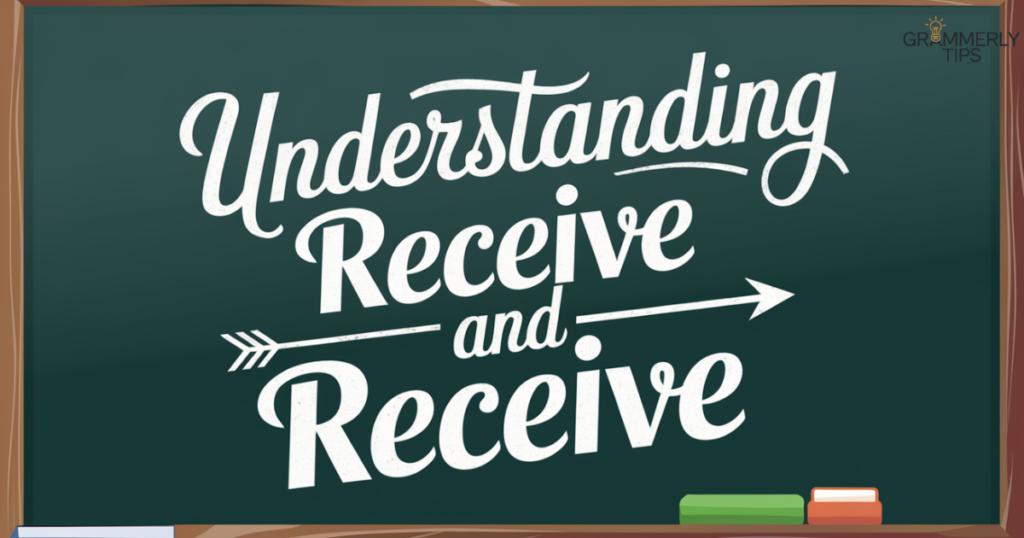When it comes to the words Recieve or Receive, many people find themselves unsure about the correct spelling. The confusion often arises from the irregularities in English spelling rules, particularly when it comes to the placement of vowels. Understanding the correct usage of these terms is important, especially since a simple spelling mistake can impact your writing’s professionalism and clarity.
The correct form is receive, which follows the well-known rule that states “i” comes before “e” except after “c.” This rule helps clarify the meaning of receive, which means to get or accept something.
In contrast, recieve is an incorrect spelling that should be avoided in standard English. By exploring the correct usage of receive, we can enhance our writing and ensure effective communication.
Understanding Recieve and Receive

Recieve: Definition and Usage
Recieve is an incorrect spelling of the word receive, which means to get or accept something. The confusion often arises due to the common misspelling, but recieve does not exist in standard English. Proper usage of receive is essential for clear communication and professionalism in writing.
This verb is often used in various contexts, such as receiving gifts, messages, or information. To maintain grammatical accuracy, always use receive instead of recieve.
You Like To Read This: Tying Or Tieing? Use The Correct Form
Receive: Definition and Usage
Receive is the correct spelling of the verb that means to get, accept, or take something, whether it’s a physical object or information. It is commonly used in both formal and informal contexts, emphasizing the act of obtaining something. Using the correct spelling is important for maintaining clarity and professionalism in writing.
Examples:
- I was excited to receive a package from my friend on my birthday.
- She will receive the latest updates via email about the project.
Side-by-Side Comparison
Here’s an updated side-by-side comparison:
| Word | Correctness | Definition | Key Difference |
| Recieve | Incorrect | A common misspelling of receive that is not recognized in standard English. | Misspelled version that should be avoided. |
| Receive | Correct | The proper verb meaning to get, accept, or take something. | Proper spelling that follows English spelling rules. |
In summary, receive is the correct form used in English, while recieve is a frequent misspelling that should be avoided. Understanding this difference is crucial for effective communication, especially in formal writing. Using receive accurately reflects attention to detail and adherence to grammatical rules.
Everyday Usage Examples

Here are five everyday usage examples of the word receive:
- I was thrilled to receive a surprise gift from my best friend on my birthday.
- The company will receive feedback from customers after the product launch.
- She hopes to receive an acceptance letter from her dream university soon.
- He always checks his email first thing in the morning to receive any important messages.
- They will receive training on the new software next week to enhance their skills.
FAQs
Which is correct, receive or recieve?
The correct spelling is receive, while recieve is an incorrect variant. Using receive adheres to standard English spelling rules.
Is it correct to say received?
Yes, received is the past tense and past participle of receive. It is used correctly in sentences to indicate that something has been accepted or obtained.
Which one is correct: yet to receive or yet to received?
The correct phrase is yet to receive, as it uses the base form of the verb. Yet to received is incorrect and should not be used.
Why is receive spelled EI?
The spelling of receive follows the English rule that states “i” comes before “e” except after “c.” This rule helps maintain consistency in English spelling patterns.
Conclusion
In conclusion, understanding the correct spelling and usage of receive is essential for effective communication. The word receive is the accurate form, while recieve is a common misspelling that should be avoided. Knowing that received is the past tense helps clarify how to use the term in different contexts.
Additionally, the phrase yet to receive correctly employs the base verb, showcasing proper grammar. The spelling of receive follows the well-known English rule regarding “i” and “e,” reinforcing its proper usage. Mastering these details not only enhances your writing but also reflects a strong command of the English language.

Grammerlytips.com, authored by Jame, offers expert tips and insights on mastering grammar, enhancing writing skills, and boosting communication effectiveness.

